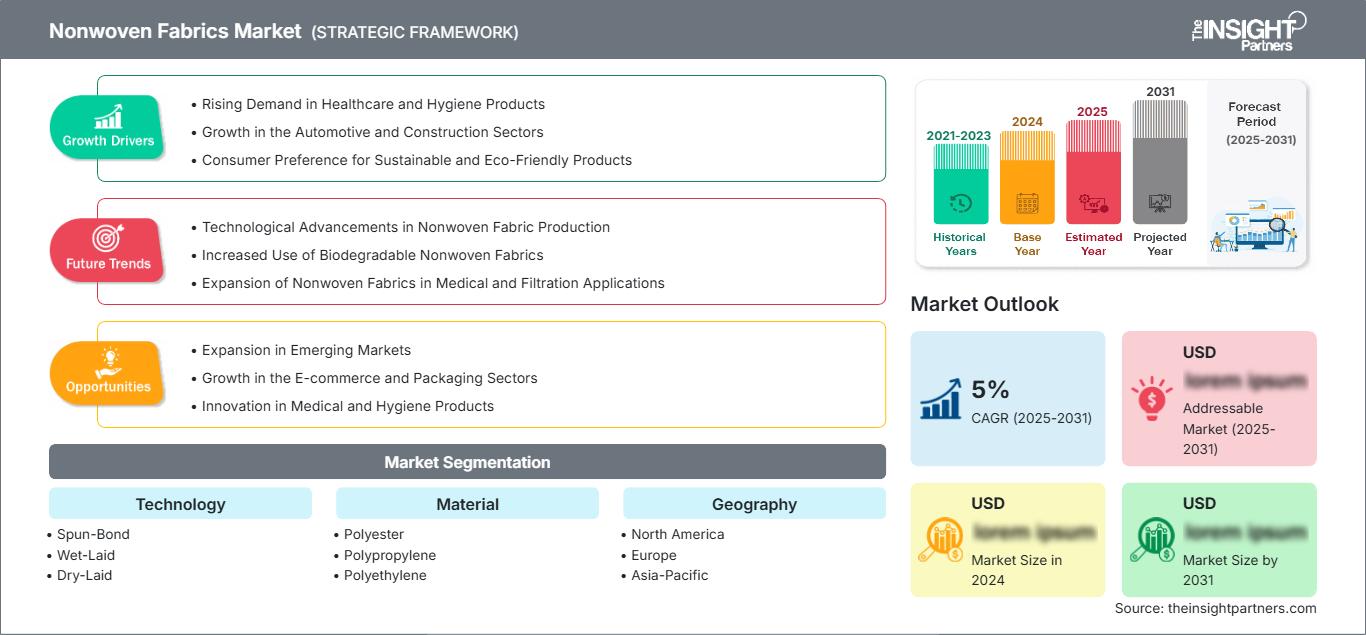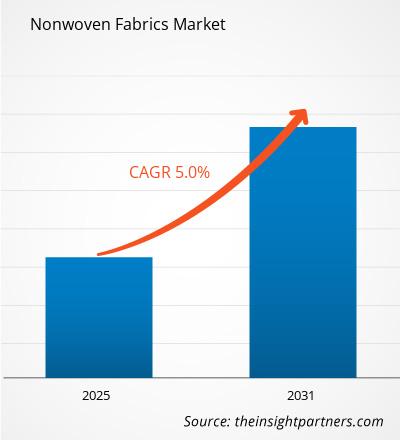Se espera que el mercado de telas no tejidas registre una CAGR del 5% entre 2025 y 2031, con un tamaño de mercado que se expandirá de US$ XX millones en 2024 a US$ XX millones en 2031.
Tamaño y pronósticos del mercado de telas no tejidas (2021-2031), análisis de oportunidades de crecimiento global y regional, tecnología (spun-bond, wet-laid, dry-laid y otras tecnologías), material (poliéster, polipropileno, polietileno, rayón y otros materiales), industria de usuario final (construcción, textil, salud, automoción y otras industrias de usuario final) y geografía (Norteamérica, Europa, Asia Pacífico, Oriente Medio y África, y Sudamérica y Centroamérica). Las telas no tejidas son un tipo de material textil que se diferencia de las telas tejidas o de punto tradicionales. Se fabrican uniendo o entrelazando fibras o filamentos en lugar de ondularlos o tejerlos. Las telas no tejidas pueden estar compuestas de fibras naturales, fibras sintéticas o una combinación de ambas.
Propósito del Informe
El informe "Mercado de Telas No Tejidas" de The Insight Partners busca describir el panorama actual y el crecimiento futuro, los principales factores impulsores, los desafíos y las oportunidades. Esto proporcionará información a diversas partes interesadas del negocio, como:
- Proveedores/fabricantes de tecnología: Para comprender la dinámica cambiante del mercado y conocer las oportunidades potenciales de crecimiento, lo que les permitirá tomar decisiones estratégicas informadas.
- Inversores: Realizar un análisis exhaustivo de tendencias respecto a la tasa de crecimiento del mercado, las proyecciones financieras del mercado y las oportunidades que existen en toda la cadena de valor.
- Órganos reguladores: Regular las políticas y las actividades policiales en el mercado con el objetivo de minimizar el abuso, preservar la confianza de los inversores y defender la integridad y estabilidad del mercado.
Segmentación del mercado de telas no tejidas
Tecnología
- Spun-Bond
- Colocación húmeda
- Colocación en seco
- Otras tecnologías
Material
- Poliéster
- Polipropileno
- Polietileno
- Seda artificial
- Otros materiales
Obtendrá personalización en cualquier informe, sin cargo, incluidas partes de este informe o análisis a nivel de país, paquete de datos de Excel, así como también grandes ofertas y descuentos para empresas emergentes y universidades.
Mercado de telas no tejidas: Perspectivas estratégicas

- Obtenga las principales tendencias clave del mercado de este informe.Esta muestra GRATUITA incluirá análisis de datos, desde tendencias del mercado hasta estimaciones y pronósticos.
Factores que impulsan el crecimiento del mercado de telas no tejidas
- Aumento de la demanda de productos sanitarios e higiénicos: Los sectores sanitarios e higiénicos son importantes impulsores del crecimiento del mercado de telas no tejidas. Estas telas se utilizan comúnmente en productos como mascarillas quirúrgicas, batas, pañales, toallas sanitarias y productos para el cuidado de heridas. Con la creciente concienciación mundial sobre la higiene y el aumento de la demanda de equipos de protección individual (EPI) debido a la pandemia de COVID-19, el mercado de telas no tejidas en aplicaciones sanitarias se ha expandido significativamente. A medida que la industria sanitaria continúa creciendo y evolucionando, también lo hará la demanda de telas no tejidas.
- Crecimiento en los sectores automotriz y de la construcción: Las industrias automotriz y de la construcción son sectores clave que contribuyen a la demanda de telas no tejidas. En la industria automotriz, las telas no tejidas se utilizan en diversas aplicaciones, como tapicería de automóviles, aislamiento, filtros e insonorización. De igual manera, en la construcción, las telas no tejidas se utilizan para geotextiles, materiales para techos y aislamiento. Con la urbanización, el desarrollo de infraestructuras y el aumento de la producción automotriz, estas industrias continúan impulsando la demanda de telas no tejidas.
- Preferencia del consumidor por productos sostenibles y ecológicos: Existe una creciente tendencia hacia la sostenibilidad y los productos ecológicos, lo que impulsa la demanda de telas no tejidas fabricadas con materiales naturales y biodegradables. A medida que más consumidores e industrias priorizan la responsabilidad ambiental, las telas no tejidas, en particular las fabricadas con fibras sostenibles como el bambú, el algodón y el PET reciclado, están ganando terreno. El enfoque en la reducción de residuos y la adopción de materiales reciclables en envases, ropa y otros bienes de consumo impulsa esta demanda.
Tendencias futuras del mercado de telas no tejidas
- Avances tecnológicos en la producción de telas no tejidas: Importantes innovaciones tecnológicas están optimizando la producción de telas no tejidas, lo que se traduce en un mayor rendimiento y eficiencia. Nuevas técnicas de fabricación, como el spunbond, el meltblown y el punzonado, han dado como resultado telas con mayor resistencia, durabilidad y resistencia al agua. Estos avances están ampliando las posibles aplicaciones de las telas no tejidas, haciéndolas más atractivas para diversas industrias, como la automotriz, la de la higiene y la de la construcción.
- Aumento del uso de telas no tejidas biodegradables: Ante el aumento de la preocupación por el medio ambiente, se ha observado una notable tendencia hacia la producción y el uso de telas no tejidas biodegradables. Estas telas se fabrican con fibras naturales como el yute, el cáñamo y el algodón, o biopolímeros, ofreciendo una alternativa ecológica a los materiales sintéticos no tejidos. La transición hacia la sostenibilidad en la producción de telas no tejidas es cada vez más frecuente, en consonancia con los esfuerzos globales para reducir los residuos plásticos y la huella de carbono.
- Expansión de las telas no tejidas en aplicaciones médicas y de filtración: La demanda de telas no tejidas en aplicaciones médicas, como mascarillas quirúrgicas, productos para el cuidado de heridas y batas médicas, ha aumentado, especialmente como respuesta a la pandemia de COVID-19. Además, las telas no tejidas se utilizan cada vez más en productos de filtración de aire y agua debido a su alta eficiencia de filtración. La creciente dependencia del sector sanitario de las telas no tejidas para productos de higiene y protección, así como el aumento de las preocupaciones ambientales que impulsan la necesidad de mejores soluciones de filtración, están impulsando esta tendencia.
Oportunidades de mercado de telas no tejidas
- Expansión en mercados emergentes: Las economías emergentes, en particular las de Asia-Pacífico, Latinoamérica y África, presentan importantes oportunidades de crecimiento para los fabricantes de telas no tejidas. A medida que estas regiones experimentan la industrialización, la urbanización y el aumento de la renta disponible, se prevé un aumento de la demanda de telas no tejidas en sectores como la salud, la higiene, la automoción y la construcción. Los fabricantes pueden aprovechar el crecimiento de la clase media y la creciente necesidad de infraestructura moderna y bienes de consumo en estas regiones.
- Crecimiento en los sectores del comercio electrónico y el embalaje: Con el rápido crecimiento del comercio electrónico, existe una creciente demanda de materiales de embalaje sostenibles y protectores. Las telas no tejidas, gracias a su ligereza, durabilidad y características ecológicas, representan una gran oportunidad para su uso en aplicaciones de embalaje. Las empresas dedicadas al desarrollo de soluciones de embalaje innovadoras con materiales no tejidos pueden aprovechar la expansión del comercio electrónico y el comercio minorista, que están adoptando alternativas de embalaje sostenibles.
- Innovación en productos médicos y de higiene: Las industrias médicas y de higiene presentan oportunidades lucrativas para los fabricantes de telas no tejidas. Las crecientes necesidades mundiales de atención médica, en particular en respuesta a crisis sanitarias como las pandemias, impulsan la demanda de telas no tejidas en productos médicos desechables, EPI y productos de higiene. Las innovaciones en telas no tejidas médicas, como sus propiedades antimicrobianas y su capacidad mejorada de barrera contra fluidos, ofrecen un mayor potencial de crecimiento. Además, la continua atención a los productos de higiene y sanitarios a nivel mundial genera una demanda continua de materiales no tejidos avanzados para pañales, productos de higiene femenina y productos para la incontinencia en adultos.
Perspectivas regionales del mercado de telas no tejidas
Los analistas de The Insight Partners han explicado detalladamente las tendencias regionales y los factores que influyen en el mercado de telas no tejidas durante el período de pronóstico. Esta sección también analiza los segmentos y la geografía del mercado de telas no tejidas en América del Norte, Europa, Asia Pacífico, Oriente Medio y África, y América del Sur y Central.
Alcance del informe de mercado de telas no tejidas
| Atributo del informe | Detalles |
|---|---|
| Tamaño del mercado en 2024 | US$ XX millones |
| Tamaño del mercado en 2031 | US$ XX millones |
| CAGR global (2025-2031) | 5% |
| Datos históricos | 2021-2023 |
| Período de pronóstico | 2025-2031 |
| Segmentos cubiertos | Por tecnología
|
| Regiones y países cubiertos | América del norte
|
| Líderes del mercado y perfiles de empresas clave |
|
Densidad de actores del mercado de telas no tejidas: comprensión de su impacto en la dinámica empresarial
El mercado de telas no tejidas está creciendo rápidamente, impulsado por la creciente demanda del usuario final debido a factores como la evolución de las preferencias del consumidor, los avances tecnológicos y un mayor conocimiento de los beneficios del producto. A medida que aumenta la demanda, las empresas amplían su oferta, innovan para satisfacer las necesidades del consumidor y aprovechan las tendencias emergentes, lo que impulsa aún más el crecimiento del mercado.

- Obtenga una descripción general de los principales actores clave del mercado de telas no tejidas
Puntos clave de venta
- Cobertura integral: el informe cubre de manera integral el análisis de productos, servicios, tipos y usuarios finales del mercado de telas no tejidas, proporcionando un panorama holístico.
- Análisis de expertos: el informe se compila con base en el conocimiento profundo de expertos y analistas de la industria.
- Información actualizada: El informe asegura relevancia comercial debido a su cobertura de información reciente y tendencias de datos.
- Opciones de personalización: este informe se puede personalizar para satisfacer los requisitos específicos del cliente y adaptarse adecuadamente a las estrategias comerciales.
Por lo tanto, el informe de investigación sobre el mercado de telas no tejidas puede ayudar a descifrar y comprender el panorama de la industria y sus perspectivas de crecimiento. Si bien existen algunas preocupaciones válidas, las ventajas generales de este informe tienden a superar las desventajas.
- Análisis histórico (2 años), año base, pronóstico (7 años) con CAGR
- Análisis PEST y FODA
- Tamaño del mercado, valor/volumen: global, regional y nacional
- Industria y panorama competitivo
- Conjunto de datos de Excel
Informes recientes
Testimonios
Razón para comprar
- Toma de decisiones informada
- Comprensión de la dinámica del mercado
- Análisis competitivo
- Información sobre clientes
- Pronósticos del mercado
- Mitigación de riesgos
- Planificación estratégica
- Justificación de la inversión
- Identificación de mercados emergentes
- Mejora de las estrategias de marketing
- Impulso de la eficiencia operativa
- Alineación con las tendencias regulatorias




















 Obtenga una muestra gratuita para - Mercado de telas no tejidas
Obtenga una muestra gratuita para - Mercado de telas no tejidas